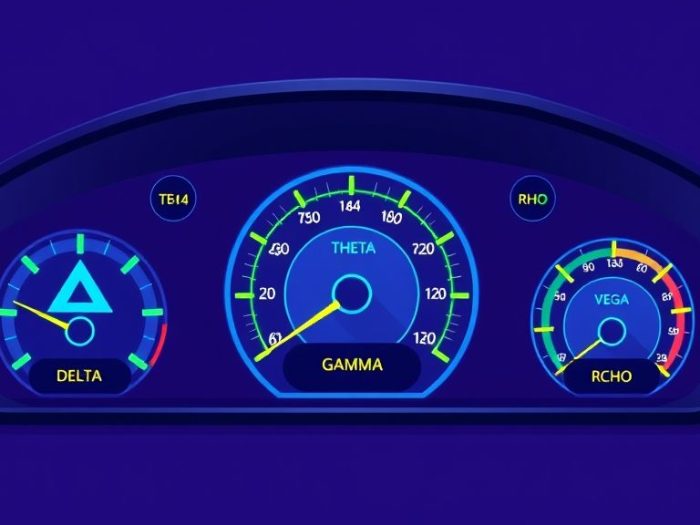Options Greeks are essential tools for options traders, providing insights into how option
prices are expected to change based on various factors. Understanding these Greeks is
crucial for managing risk and making informed trading decisions. This article explains the
five main options Greeks: Delta, Theta, Gamma, Vega, and Rho.
Understanding Options Greeks
Options Greeks are measures of the sensitivity of an option’s price to changes in underlying
variables. They help traders quantify the risk and potential reward of options trades.
The Five Main Options Greeks
1. Delta
Delta measures how much an option’s price is expected to move for every $1 move in the
underlying stock price.
- Delta ranges from -1 to 1.
- A call option has a positive delta (0 to 1).
- A put option has a negative delta (-1 to 0).
- A delta of 0.50 means the option price is expected to move $0.50 for every $1 move in the stock price.
2. Theta
Theta measures how much an option’s price is expected to decrease over time, all else being
equal. It represents time decay.
- Theta is always negative for options.
- Theta increases as expiration approaches, meaning options lose value faster closer to expiration.
3. Gamma
Gamma measures the rate of change of Delta for every $1 move in the underlying stock price.
- Gamma is highest for at-the-money options and lower for in-the-money and out-of-the-money options.
- Gamma is positive for both calls and puts.
4. Vega
Vega measures how much an option’s price is expected to move for every 1% change in implied
volatility.
- Vega is positive for both calls and puts.
- Options prices increase when implied volatility increases and decrease when it decreases.
5. Rho
Rho measures how much an option’s price is expected to move for every 1% change in interest
rates.
- Rho is generally small and has a more significant impact on long-term options.
- Rho is positive for calls and negative for puts.
How to Use Options Greeks
Options Greeks are used for:
- Risk Management: Assessing and managing the various risks associated with options trading.
- Strategy Selection: Choosing the right options strategy based on your market outlook and risk tolerance.
- Position Sizing: Determining the appropriate number of options contracts to trade.
- Profit Target and Stop-Loss Placement: Setting realistic profit targets and stop-loss levels.
Example
A trader who expects a stock price to rise significantly might focus on Delta and Gamma to
maximize potential profits from the upward move. They would also consider Theta to manage
time decay, especially if holding the option for an extended period.
Important Considerations
- Dynamic Nature: Greeks are not static; they change as the underlying stock price, time to expiration, and volatility change.
- Approximations: Greeks are estimates and not perfect predictors of price movement.
- Combined Use: Greeks should be used in conjunction with other technical and fundamental analysis tools.
Conclusion
Understanding options Greeks is essential for effective options trading. By quantifying the
various factors that influence option prices, traders can better manage risk and make more
informed decisions. However, remember that Greeks are tools and should be used as part of a
comprehensive trading strategy.
Related Keywords
Options Greeks, Delta, Theta, Gamma, Vega, Rho, options trading, options risk management,
options trading strategies, options trading for beginners, options pricing, options
analysis.
Frequently Asked Questions (FAQ)
1. What are options Greeks?
Options Greeks are measures of the sensitivity of an option’s price to changes in
various underlying variables, such as stock price, time, and volatility.
2. What does Delta measure?
Delta measures how much an option’s price is expected to move for every $1 move
in the underlying stock price.
3. What does Theta measure?
Theta measures how much an option’s price is expected to decrease over time
(time decay).
4. What does Gamma measure?
Gamma measures the rate of change of Delta for every $1 move in the underlying
stock price.
5. What does Vega measure?
Vega measures how much an option’s price is expected to move for every 1%
change in implied volatility.
6. What does Rho measure?
Rho measures how much an option’s price is expected to move for every 1%
change in interest rates.
7. How are options Greeks used in trading?
Options Greeks are used for risk management, strategy selection, position
sizing, and profit target and stop-loss placement.
8. Do options Greeks remain constant?
No, Greeks are dynamic and change as the underlying stock price, time to
expiration, and volatility change.
9. Are options Greeks perfect predictors of price movement?
No, Greeks are estimates and not perfect predictors of price movement.
10. Should options Greeks be used in isolation?
No, Greeks should be used in conjunction with other technical and fundamental
analysis tools.



